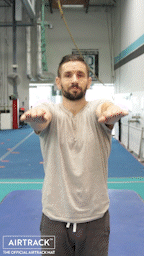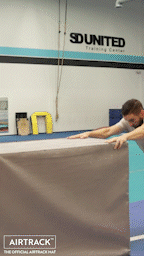How to Do a Flip
It is important to have a background in training that would prepare you to learn how to flip before doing so. Gymnastics, martial arts, dance, parkour, and cheerleading are all great sports to have skills in before attempting to learn how to flip. If available, always consult a coach to see if they think you are prepared to attempt a flip. Regardless of skill level, the most important factor in learning any new skill is comfortability. You should never attempt to learn any new skill that you don’t feel ready to learn.
With all of that in mind, let’s take a look at some skills you should have down before learning how to front and back flip!
● Forward and backward gymnastics rolls
● Forward dive roll
● Punch jumps and proper hurdling techniques
● Tuck jumps for height and positioning
● Roundoffs
● Front and back handsprings
It is highly recommended that you use a trampoline when you are first starting to learn how to do a flip. The bounce from the trampoline will help your body get acquainted with positioning. Once you feel comfortable on the trampoline, it is time to try to perform the skill on the ground. It is important to have a softer surface to land on when practicing on hard surfaces like carpet, hardwood floors, or grass. A crash mat or wide yoga mat will work well. AirTracks can often give the best experience, as it will provide an extra bounce to stick landings and boost jumps that you won’t get from other soft surfaces.
How to Do a Backflip
Backflips are a challenging skill to master and perform correctly. There are two approaches to performing a backflip: doing a sequence of tricks to build momentum (easier) or standing (more difficult). When first learning how to do a backflip, it is often easier to start with a tumbling pass before attempting to master performing a standing backflip.
1. Solidify backflip positioning


A strong tuck position is the first and most important part of learning how to do a backflip. When practicing, pay close attention to keeping your knees close to your chest while holding your core tight. Practicing on a block will reinforce a high jump while tucking your legs and keeping your neck neutral.
2. Practice rotation of the backflip from high to low surface
You can start practicing a backflip from a higher surface to a cushioned, lower surface once you feel prepared. A great option is the AirTrack Vaulting Box, as it will give you a boost while providing more room to learn how to flip. This will also help reinforce confidence and muscle memory.
3. Practice rotation of the back flip on a trampoline
Once you have developed the correct positioning, you can transfer these skills onto a trampoline. Practicing on a trampoline teaches your body muscle memory for when you are prepared to move on to a full backflip. Start with a round-off and go in for the backflip, keeping a tight tuck in the knees against your chest and opening your chest while getting your hips up and over your head. If you need more momentum, do roundoff into a backhand spring then backflip. Doing this on a trampoline will prepare you to move to the floor by building confidence, strength, and muscle memory.
4. Practice rotation of the backflip on springboard or AirTrack
Now that you’ve practiced on the trampoline and you feel comfortable with doing a backflip, it is time to move to a soft surface on the ground. Using an AirTrack mat is a great way to practice learning how to do a backflip. You can adjust the pressure and start on a soft and bouncy surface, then gradually increase the pressure to mimic a hard, solid surface reminiscent of performing the skill on the ground. If able, it is always recommended to have someone spot you while learning.
5. Progress to practicing backflip on solid floor


Before moving to solid ground, make sure you are perfectly comfortable doing a back flip off a springboard or AirTrack. For the first few times of performing a backflip on solid floor, it is recommended that you have a knowledgeable coach, friend, or parent spot you through the process. Gradually transition on to doing a back flip with less assistance after several successful back flips with a spotter.
6. Add your back flip onto your tumbling pass
You did it! Now that you have perfected your back flip, you can add it to an entire tumbling pass. A simple roundoff, back handspring, or back tuck, for example, elevates the difficulty of your tumbling pass, hence making you a higher-level tumbler. It looks flashy and exciting, making it a great addition to any routine, as long as it is always performed properly and carefully.
For a more detailed explanation visit How to do a Back Flip
How to Do a Front Flip
Front flips are fun and exciting but can prove to be challenging while your body gets used to the forward motion at the beginning. The most popular way to do this is by running into a punch jump and then flipping. The punch jump and a good forward roll are key to get right. Practicing this is extremely important and gives you the height and momentum to complete the rotation of the front flip.
1. Solidify front flip positioning


Start by practicing forward rolls on a mat to get a handle on front flip positioning. When comfortable with forwarding rolls, practice jumping into a tucked position on a trampoline. This will help your body understand where it needs to be before you start the actual front flip. When learning how to do a front flip, you must have a strong punch just, as this will give you the momentum needed to get your body over.
2. Practice rotation of the front flip from high to low surface
Starting by jumping from a higher surface to a lower surface helps to get your body used to the rotation. To do this, we suggest having something like a Vaulting Box, which gives you the customizable height to practice off of. Once you have the height, practice your rotation onto a soft surface. Additionally, practice getting your hips over your head. Place your hands on to the vaulting box or block, and jump off the ground to elevate your hips, keeping your arms and ears in line. If an AirTrack, block, vaulting box or similar is not available, place your hands on the ground and perform the same movement, pushing your feet off the floor and transitioning on to a forward roll. Going through this range of motion several times will assist in getting you used to the forward rolling motion seen in front flips. As with any new skill, it is highly recommended to have someone spot you the first few times.
3. Practice rotation of the front flip on a trampoline
Now that you’ve practiced from a higher surface, you can move onto the trampoline. Here you will do a punch jump into a front flip. The punch jump is one of the most important aspects when you are learning how to do a front flip, so make sure you are practicing it correctly when on the trampoline.
4. Practice rotation of the front flip on spring board or AirTrack


Once you have mastered performing a front flip on a trampoline and you are feeling confident, it is time to move onto a soft floor. We recommend the Home AirFloor, as it is easy to set up, store and it provides the ability to regulate the air pressure to the desired softness or hardness, which cannot be done on similar soft surfaces like a crashmat, a stack of pillows, or yoga mats. Once again, make sure to have a spotter next to you to support you in this next learning stage.
5. Progress to practicing front flip on solid floor
When you perfect doing a front flip on a soft surface, you can move onto solid ground. You will experience the most momentum and impact on your landing when performing a front flip on soft ground, so make sure you take the time to ensure your form and technique is perfect. Pay special attention to your knees’ when grabbing your tuck; leave a gap in between your knees so that there is enough space for your head to come forward if you land short. Once confident, get a running head start, punch jump, and flip.
You have officially mastered a front flip!
For a more detailed explanation visit How to do a Front Flip.
How to Do a Side Flip
Side flips are the less conventional of the flips and are often seen in hip hop dancing, freerunning, and parkour. Side flips have a very similar form and prep to a front flip. Many people even do them off of a wall or just from a standing position. They are extremely fun and flashy to perform in front of others.
Prep for Executing a Side Flip
Since the side flips are different in both direction and structure compared to front and back flips, the preparation looks slightly different. You must adjust your body to be able to complete the flip from the side.
Here are some prerequisites you should have before you attempt a side flip;
● Cartwheels
● A cartwheel is where you put your hands on the floor and flip your body in a wheel-like shape.
● This helps prepare your body for side movement.
● Front flips
● As mentioned above, a front flip is when you run into a punch jump and flip in a tuck position forwards
● This helps you understand the mechanics of actually doing a flip
● Building forward momentum and height
● Running and punch jumps give you momentum
● Practicing these will help you in getting over with enough height for your flip
● Using arms to swing the body up
● Running and then throwing your arms up and pushing them back
● Throwing your arms helps give extra momentum
● Rolling over the back of a spotter, block, or AirRoll (to practice side flip motion)
● Use an AirRoll to roll over, stack up a block at a good height, and roll over it
● This will help your body understand the right positioning of the side flip.
1. Use a trampoline to practice side flip motion
A trampoline will enable you to teach your body how to move in a side motion, along with having the bounce and getting comfortable with it. This helps you build confidence and correct form to move to a softer surface. The proper “form” for a side flip is a little more subjective: some hold their knees for a slightly more tucked position while others might place their hold behind their knees. Do whatever one feels most comfortable.
2. Practice takeoff from running start to launch
Figuring out how to get into the position from a running head-start is one of the more difficult things to master, as it is hard for your body to adjust to such an unnatural position. Start by running and turning sideways for your punch jump then using that momentum to get your body over. Another way commonly used is to run and step into the side flip. This is a less popular way to do perform a side flip, but some find it easier to do. Find what feels right for you, always keeping close attention to proper form and technique.
3. Use a spring board or AirFloor to execute the side flip
You will lose a lot of bounce when transferring from trampoline to floor, which can be hard for the body to adjust to. To make the transition easier, try using a spring board or an AirTrack to assist in the transition.
The Best Way to Learn to Do a Flip
Now you should understand how to do a front flip, back flip, and side flip. All three are unique in their own way and take time to master. Patience and practice are key! Always consult a coach or trained professional before attempting any of these skills. Safety is of the utmost importance; make sure you take every precaution possible. We suggest equipping yourself with AirTrack products, which will provide the most versatility and flexibility to adjust with you, regardless of whatever skill you are practicing. AirTracks are easy to store, set up, and take with you, so you can train anywhere you’d like.

 408-569-9504
408-569-9504



